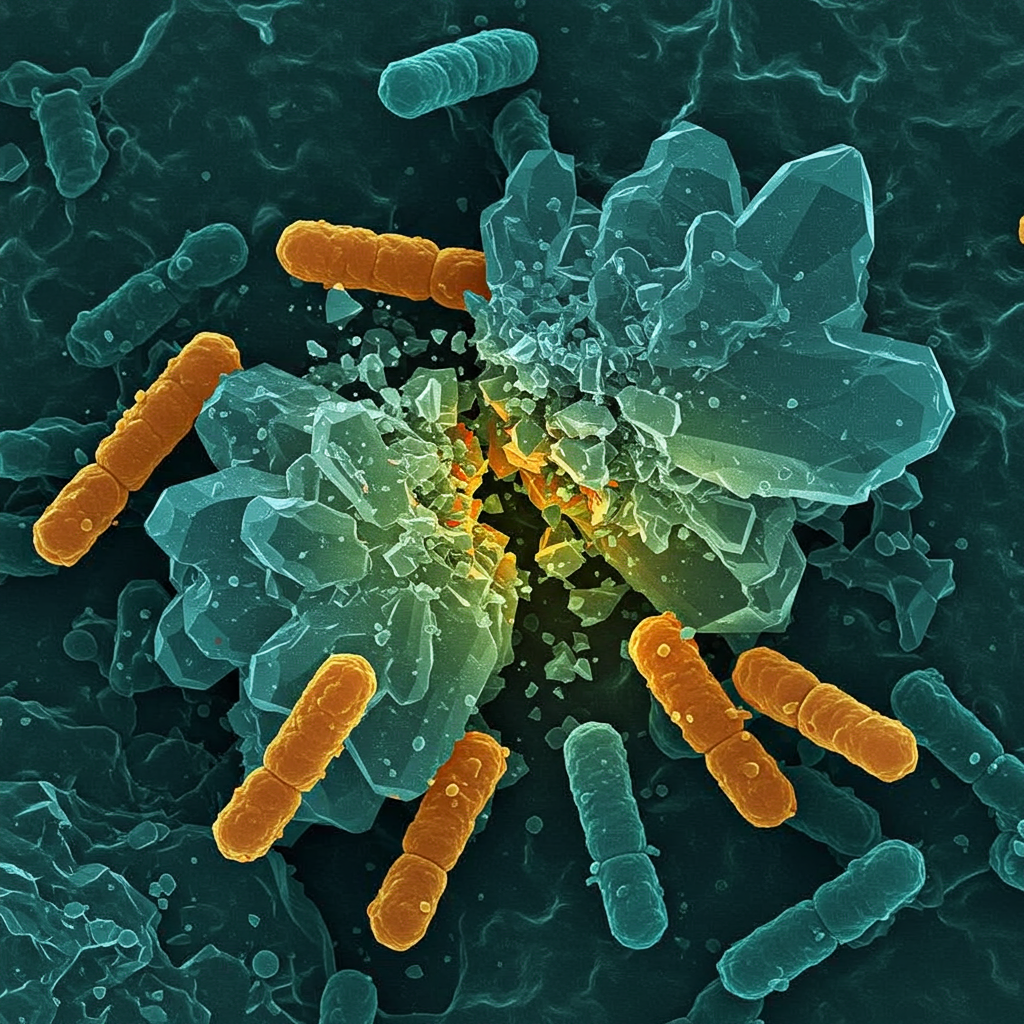For decades, insidious chemicals known as PFAS have infiltrated our environment and our bodies. Dubbed “forever chemicals” because they resist breaking down, these substances are now virtually everywhere, linked to a frightening array of health issues from cancer risks to immune system dysfunction. The challenge seems insurmountable: how do we eliminate compounds designed specifically to persist? Recent scientific efforts offer glimmers of hope, tackling the problem from different angles – from breaking down concentrated chemicals to potentially helping our own bodies expel them using the power of gut microbes.
The Persistent Threat of PFAS Forever Chemicals
PFAS, or per- and polyfluoroalkyl substances, are a vast family of synthetic chemicals. Numbering over 4,700 different types, they share a common feature: incredibly strong carbon-fluorine bonds. It’s this unique molecular structure that grants them their valuable properties – resistance to water, grease, and stains – and simultaneously makes them nearly indestructible in nature and within the human body.
These chemicals are added to thousands of consumer and industrial products worldwide. You might find them in:
Non-stick cookware coatings
Waterproof clothing and textiles
Food packaging (like grease-resistant wrappers)
Firefighting foam (AFFF)
Furniture and carpet treatments
Some cosmetics and personal care items
Their widespread use means PFAS have contaminated soil, water, and air globally. Exposure is common, primarily through contaminated drinking water, food (especially contaminated fish or packaged goods), inhaling dust, and using products containing them. Disturbingly, studies indicate that PFAS are present in the blood of nearly every American.
Documented Health Concerns Linked to PFAS Exposure
While initially believed to be safe, the pervasive presence of PFAS has revealed a disturbing link to numerous health problems, even at low levels. Scientists and health organizations now recognize PFAS as “slow poisons” due to their accumulation and potential long-term effects. Health issues statistically associated with PFAS exposure affect virtually every major organ system in the body.
These potential health risks include:
Increased risk of certain cancers (e.g., kidney, testicular)
Liver damage and altered liver enzyme levels
Immune system suppression (e.g., reduced antibody response to vaccines, increased severity of Covid-19)
Thyroid disruption
High cholesterol
Increased risk of developing diabetes
Fertility issues and negative pregnancy outcomes (like low birth weight)
Developmental delays and effects in children
Some types of PFAS, particularly those with longer carbon chains, can linger in the human body for years, even decades. This persistence makes finding ways to remove or mitigate their effects a critical public health challenge.
A Surprising Discovery: Gut bacteria to the Rescue?
For years, researchers have sought effective ways to eliminate PFAS from the environment and the body. While some methods exist for filtering PFAS from water, removing them once inside the body has been far more challenging. A recent breakthrough from scientists at the University of Cambridge’s MRC Toxicology Unit in the UK offers a novel and potentially game-changing approach using the body’s own microbial residents.
The Cambridge team, led by senior study author Dr. Kiran Patil and including Dr. Anna Lindell (first author) and Dr. Indra Roux, investigated whether the human gut microbiome could play a role in tackling these persistent chemicals. Their findings were published in the journal Nature Microbiology.
How Gut Microbes Might Help Fight Forever Chemicals
The key discovery is that certain species of human gut bacteria possess a remarkable ability: they can actively absorb PFAS molecules from their surroundings. Dr. Patil explained that these bacteria can “soak up PFAS from their environment at a range of concentrations.”
Once absorbed, the bacteria don’t just sit there; they have a mechanism to manage the chemicals. The study found that the bacteria store the PFAS molecules in dense clumps inside their cells. This clumping appears to be a protective mechanism, shielding the bacteria themselves from the toxic effects of the chemicals.
The next step was to see if this absorption capability could help remove PFAS from a living system. Researchers introduced nine identified bacterial species into the guts of mice that had ingested PFAS. The results were promising. Within minutes of the mice consuming the chemicals, the added bacteria began collecting the PFAS.
Crucially, the study showed that the accumulated PFAS, now sequestered within the bacteria, were then excreted from the mice’s bodies through their feces. The bacteria were surprisingly effective, gathering between 25% and 74% of the ingested toxins, demonstrating a significant capacity for removal regardless of the initial concentration in the mouse’s gut.
Future Potential: Probiotics for PFAS Detox?
The Cambridge team is highly optimistic about the potential applications of their discovery. If further testing in humans yields similar positive results, they plan to develop new strategies leveraging these beneficial microbes. The primary goal is to create specific probiotic dietary supplements containing the helpful bacteria species.
These potential probiotic supplements would aim to increase the levels of the PFAS-absorbing microbes in the human gut. By boosting these bacteria, the supplements could theoretically enhance the body’s natural ability to capture and expel PFAS through the digestive system. Dr. Lindell and Dr. Patil have already co-founded a startup company, Cambiotics, specifically to pursue the development of this innovative probiotic approach. This research offers a fascinating new perspective on how the complex ecosystem of our gut microbiome might be harnessed to protect our health from modern environmental contaminants.
Other Research Angles: Fiber and Chemical Breakdown
The gut bacteria study is just one piece of the puzzle in the fight against PFAS. Scientists are exploring multiple avenues:
Dietary Fiber: A separate study published earlier suggests that certain types of fiber, such as beta-glucan found in oats, may also bind to PFAS in the digestive tract. This binding could potentially aid in flushing these chemicals from the body via feces, offering a simple dietary strategy to complement microbial approaches.
Chemical Destruction: While the gut bacteria help remove PFAS from the body, researchers are also working on methods to destroy PFAS in the environment. Scientists at Northwestern University, for instance, developed a relatively low-temperature chemical process using lye and dimethyl sulfoxide that can break down certain classes of PFAS (like PFOA and GenX) in concentrated form, converting them into harmless substances. This method, published in Science in August 2022, is intended for treating contaminated water after filtration and shows promise for environmental remediation, though it doesn’t work on all PFAS types.
These different research pathways highlight the multifaceted nature of tackling PFAS contamination – from cleaning up the environment to helping the human body detoxify.
The History of Secrecy and What You Can Do Now
Adding complexity to the current challenge is the historical context of PFAS use. Internal documents from companies like 3M reveal that they were aware of the toxicity and presence of PFAS in the general population’s blood as early as the late 1970s. Despite this knowledge, information was reportedly suppressed for decades, contributing to the widespread contamination we face today. Regulatory efforts are ongoing, but the sheer number of PFAS compounds makes comprehensive regulation difficult, sometimes described as a “chemical wack-a-mole.”
Given that PFAS are already ubiquitous, mitigating exposure and potential health impacts is crucial now, while research into removal methods continues.
Here are some practical steps you can take:
Check Cookware: Avoid non-stick pans labeled with “PFOA” or “PFOS.” While these specific compounds might be phased out, other PFAS may be used unless the product is explicitly labeled “PFAS-free” or “certified nontoxic.” Consider using stainless steel, cast iron, or ceramic alternatives.
Filter Your Water: Drinking water is a major exposure source. Use a high-quality water filter certified to remove PFAS. Reverse osmosis filters are generally considered the most effective. The Environmental Working Group (EWG) provides resources and maps to check local water contamination.
Be Mindful of Products: Look for “PFAS-free” labels on food packaging, furniture, carpets, and clothing. Be wary of items marketed as stain-resistant or waterproof without clear labeling about the chemicals used.
Reduce Dust: PFAS can attach to dust particles. Regularly clean and dust your home, using a vacuum cleaner with a HEPA filter to capture contaminated dust.
- Research Local Contamination: Check local news and environmental agency reports, especially if you live near industrial sites, military bases, or airports that historically used firefighting foams containing PFAS.
- nypost.com
- www.bbc.com
- www.vox.com
- www.propublica.org
- www.healthday.com
The potential for gut bacteria to assist in removing PFAS from the body is an exciting development. While we await human trials and the development of specific probiotics, understanding the risks and taking proactive steps to reduce exposure remains our most immediate line of defense against these persistent forever chemicals.
Frequently Asked Questions
How can gut bacteria potentially help remove PFAS forever chemicals from the body?
Recent research from UK scientists discovered that certain species of human gut bacteria can absorb PFAS molecules from their surroundings. In studies using mice, these bacteria were shown to collect ingested PFAS within minutes and store them in clumps inside their cells. The PFAS-laden bacteria were then excreted from the body via feces, effectively removing the chemicals from the host organism. This process suggests the gut microbiome could act as a natural defense mechanism.
What are practical ways to reduce my exposure to PFAS chemicals today?
You can reduce PFAS exposure by making conscious choices. Avoid non-stick cookware made with PFAS (look for alternatives like stainless steel or cast iron). Filter your drinking water using systems certified to remove PFAS, such as reverse osmosis filters. Be mindful of food packaging and consumer products like waterproof clothing or stain-resistant furniture, looking for “PFAS-free” labels. Regularly clean your home to reduce contaminated dust.
Why are PFAS called “forever chemicals” and what are their main health concerns?
PFAS are called “forever chemicals” because they contain extremely strong carbon-fluorine bonds that are very difficult to break down, meaning they persist in the environment and the human body for many years or even decades. Their main health concerns include links to increased risks of certain cancers, liver damage, immune system suppression, thyroid issues, high cholesterol, fertility problems, and developmental effects in children, impacting nearly every major organ system.



